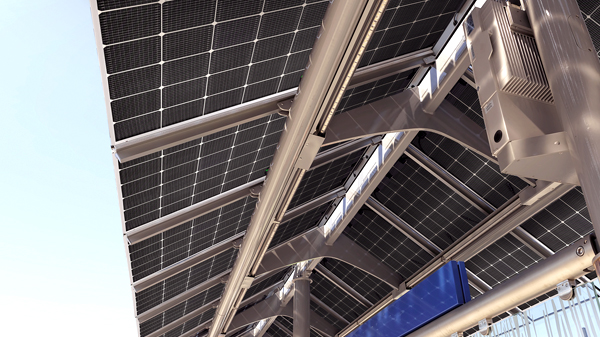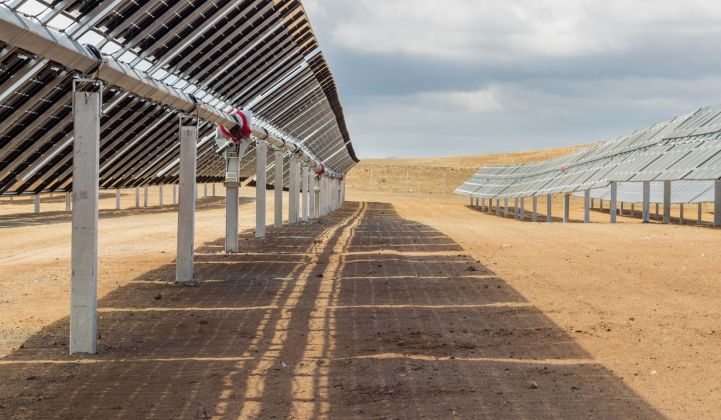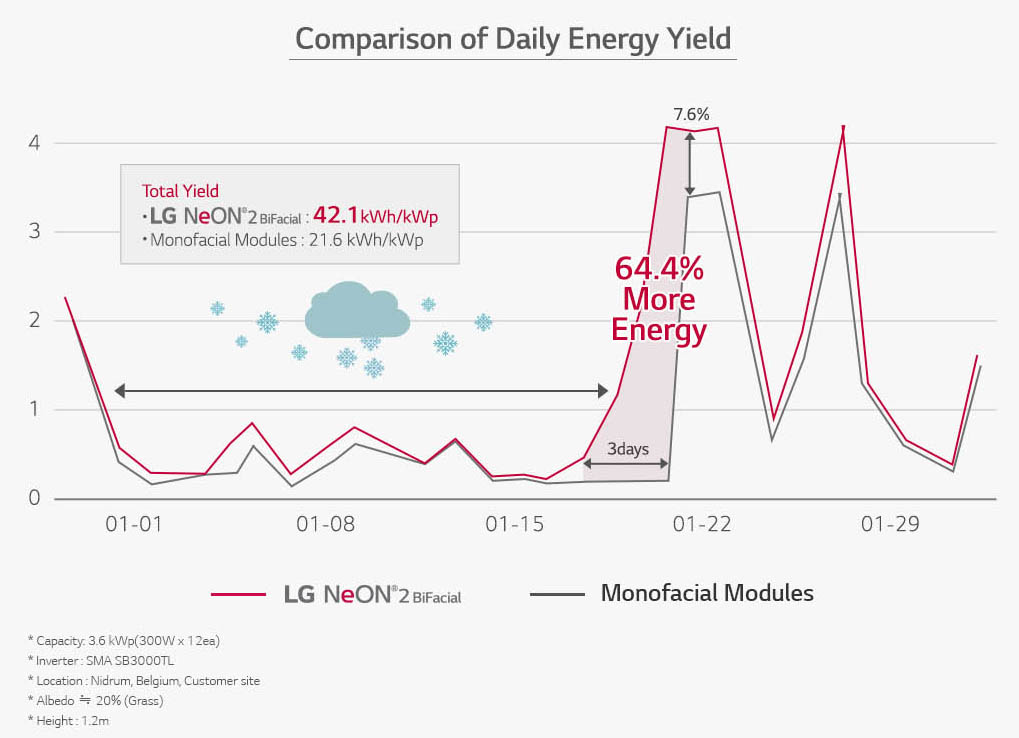 Loading... Please wait...
Loading... Please wait...Products
- DC Appliances
- Solar Refrigerators and Freezers
- Solar Panel Kits
- Solar Panels
- Solar Generators
- Inverters
- Inverter Monitoring
- Inverter Accessories
- Balance of Systems
- Racking and Mounting
- Rails
- Flashings
- Splice Kits
- Stopper Sleeves
- Conduit Mounts
- Attachments
- Brace Assembly
- Base Mount
- Brackets
- Bolts
- Clamps
- Caps
- L-Feet
- Washers
- Skirt
- Lugs
- Tilt Legs
- Hooks
- Stand-Offs
- Ballast Bay
- Top of Pole Mount
- Side of Pole Mount
- Flush Mount Kits
- Ground Mount Kits
- Roof Mount Kits
- Hardware Packages
- Wire Management
- Batteries
- Battery Accessories
- Charge Controllers
- Tools and Supplies
- View All Products
Solaris Blog - LG Bifacial Solar Panels
Bifacial Solar Panels: What You Need to Know
Posted by Brandi Casey on 3rd Mar 2020

Bifacial solar panels have solar energy cells on both the front and back side of the solar panel. This allows solar energy to be collected on the backside of the panel and enhance the energy output of the solar energy system. Traditional solar panels utilize a layer of solar cells on the front side of the solar module, and have a white or black back-sheet on the back. Under the correct installation conditions, bifacial gain can more completely take advantage of solar energy collection by capturing light through this dual energy capture process - Both on the front side, and the back side of the solar panel.
Bifacial solar panels utilize technology across modern advancements in solar module and cell development, such as, high watt modules, higher efficiency panels, half cut cell designs and more. Many solar panel manufacturers such as LG Solar, Longi, and Canadian Solar are producing new panels over 300w+, with 400w+ modules on the market. High watt solar panels allow you to obtain further cost advantages through both lowering the bill of materials and driving down installation costs.
The higher efficiency rating of solar modules not only increases your overall energy output, but the output of your solar energy system under less than ideal sun conditions. While half-cut cell technology reduces the risk of “hot spots” developing on your modules, extending the lifetime of the module and increasing the output of your modules.
Bifacial solar panel technology takes advantage of all three of these technologies, and combines them into a singular module, capable of producing up to 30% more energy output. Bifacial solar panels are designed with solar cells on both sides of the module, unlike traditional modules. If you are looking to maximize the output of your solar energy system, bifacial solar panels may be one of the best solar panel options for you.
To find out more about Bifacial Solar Panels, we will be analyzing the following:
- Bifacial Solar Panel Technology
- Recommended Installation Conditions
- Bifacial Solar Panel Comparison
- Solaris Recommendations
Bifacial Solar Panel Technology
 Bifacial modules double-sided solar cell design and
transparent back-sheet allow light to be captured by both sides of the solar
panel. This is accomplished by the backside of the panel capturing light that is
reflected onto the underside of the module off the ground beneath the panel. This
means that there must be enough space between the underside of the panel and
the ground to allow light to reflect onto the module.
Bifacial modules double-sided solar cell design and
transparent back-sheet allow light to be captured by both sides of the solar
panel. This is accomplished by the backside of the panel capturing light that is
reflected onto the underside of the module off the ground beneath the panel. This
means that there must be enough space between the underside of the panel and
the ground to allow light to reflect onto the module.
Bifacial panels are listed at their front-side output rating, expected bifacial output varies by solar panel and manufacturer as well as environmental conditions. For example, Canadian Solar can achieve up to 30% bifacial gain but may only achieve 5% depending on outside lighting conditions. Bifacial gain is largely determined by the amount of light that hits the back of your modules.
Bifacial modules are manufactured to be compatible with market ready power converting solutions like string inverters and microinverters. Furthermore, bifacial panels perform better under low light conditions. LG Solar’s NeON2 bifacial panels have been tested to produce up to 64.4% more energy over three-day period following a snowstorm. Their study also showed that the modules performed slightly better or on par with single sided modules during days in which it was actively snowing.
Recommended Installation Conditions
Due to the fact that bifacial panels obtain their gain from reflected light on the back side of the panel, they are not recommended for the majority of roof mount installations. For flush mount and most tilt mount roof top solutions, there is not enough space between the module and the roof face to reflect light onto the underside of the panel. Therefore, the dual energy yield will either under-perform, or not perform at all. Installations using flush mount solutions should avoid using bifacial modules, while tilt mount installs should review their site and roof for feasibility.
Bifacial modules work best for ground mount, top of pole and awning installations. Bifacial gain is further enhanced if the surface that the system is installed on is reflective. Homeowners interested in utilizing pergolas or deck overhangs may also benefit from dual-sided technology.
The modules work well under a number of extreme environmental conditions. As mentioned in the case of LG, bifacial modules outperform traditional modules in the days following a snowstorm. This is because the underside of the panel actively captures the light reflected from the white of the snow and produce energy. As an added bonus, this will also heat the panel and assist in melting snow on the front side of the module.
LG vs Longi Solar Bifacial Panel Comparison
Bifacial solar panels are currently being produced by a number of tier one manufacturers. To better understand your options, we have selected two bifacial modules at different price points: Longi Solar (value-based) and LG Solar (premium).
The way manufacturers measure their bifacial gain varies, as noted in the chart below. To best interpret your potential output, consider the differences in the ratings. Also note efficiency ratings when doing so, for example, the back panel efficiency rating from LG Solar is much higher than the Longi module. LG Solar bifacial modules on average offer up to 30% more power generation while Longi Solar's bifacial modules offer up to 25% power generation.
| Nominal Power | Opt. Voltage (Vmp) | Opt. Current (Imp) | Price per Watt | Efficiency | Documents | |
LG Solar - LG400N2T-J5 |
400W (Bifacial Gain 425W / 450W) |
41.5V |
9.65 Amps (Bifacial Gain 10.24V / 10.84V) |
$0.85 |
19.3% (Bifacial Gain 20.5% / 21.7% | Pricing Specifications Warranty |
Longi Solar - LR6-72BP-360 |
360W Front / 270W Back |
39.3V Front / 39.8V Back |
9.16A Front / 6.79A Back |
$0.50 |
18.3% Front / 13.7% Back | Pricing Specifications Warranty |
*Price per watt based on pricing as of the posting of this blog.
LG Solar solar panels come with 25 year linear performance and 25 year product warranties, while Longi matches LG's linear performance warranty, and a 10 year product warranty. In addition, LG modules are guaranteed to produce 90.08% of their nameplate power at the 25 year mark, while Longi guarantees 83.8% of their nameplate power. Longi comes in at a lower initial price point, averaging between $0.30 - $0.40/watt less than LG Solar.
When compared to non-bifacial modules, both bifacial panels have the potential to output more energy daily, and throughout the solar modules lifetime. For installation sites that are exposed to high snow loads annually, ground mount bifacial installations benefit from the reflective light of the snow, and drastically increase performance during the winter months. If these conditions fit your installation site, you may benefit from bifacial modules and require less solar panels and overall equipment if you use bifacial.
Winner: LG Solar
While Longi Solar's value based cost makes it more affordable than LG Solar's bifacial modules, LG offers more out of the box power, higher efficiency, and the longest and most extensive warranty period. This offers the potential for a greater return on your investment over time.
Solaris Recommendations

Bifacial solar panels should be considered for ground mounted solar installations, particularly for sites that have high energy demand like commercial installations and utility scale projects. It is further recommended that the surface underneath the module be at least semi-reflective, this will ensure that you get the most out of the back-end of the module and the most bifacial gain. The price point of bifacial modules correlates with average price points for the brand.
Bifacial solar panels are compatible with both string and microinverter solar energy systems, and are compatible with most solar racking manufacturers. However, there may be exceptions regarding racking, frame-less bifacial modules require specialty racking equipment, namely, specialized mid and end clamps. IronRidge carries some frame-less racking solutions, customized racking solutions may be necessary from some bifacial modules.
Like all microinverter installations, you should plan out the possibility of clipping, which may be more likely with microinverter systems on a modular level, especially when the sun is at its peak. We recommend using the highest rated microinverter that is compatible with your bifacial module, in the case of Enphase Energy, the IQ7PLUS or the IQ7A are recommended over the IQ7 microinverters for this reason.
We recommend bifacial modules for installation sites that can benefit for bifacial gain, meaning, that residential homeowners with roof mount installations are advised to seek other solar panel solutions. Under the right conditions, bifacial modules can produce more power with less equipment, saving in both initial investment cost, and increasing your return on investment.
See Here: Silfab vs Axitec Solar Panels: What's Best?




